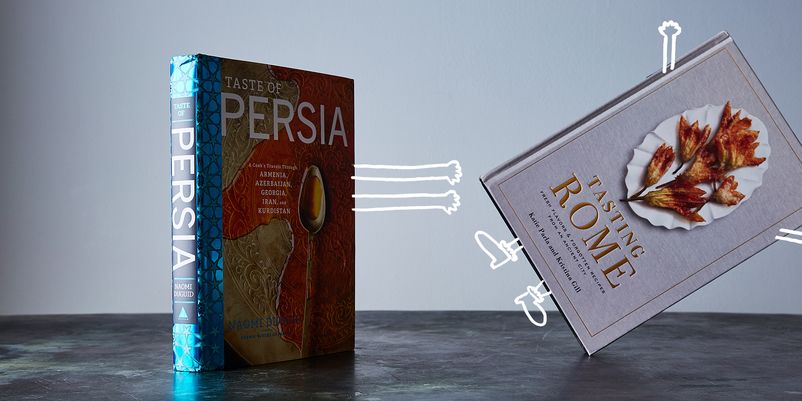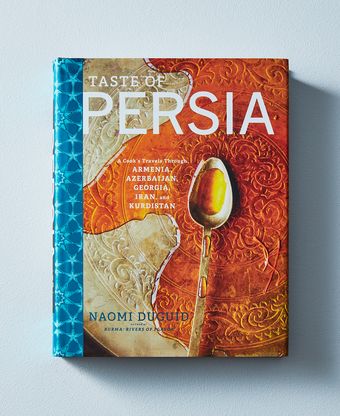Watch Katie's first-ever Piglet video judgment, or read the transcript—we've pasted it below for your convenience. (And you can find more of Katie's videos here.)
Food52 is one of my favorite food websites and culinary resources. Every year they hold an epic cookbook challenge called The Piglet. This year they asked me to be a judge and I was so honored I couldn’t say no.
The two books they assigned me were: Tasting Rome: Fresh Flavors & Forgotten Recipes From an Ancient City and Taste of Persia: A Cook’s Travels Through Armenia, Azerbaijan, Georgia, Iran, and Kurdistan.
Tasting Rome, Taste of Persia. (Let’s taste another part of the world, shall we?) Both cookbooks are culinary travelogues. They are about places just as much as they are about the food; in fact, these books make the case for the two being inseparable.
And lucky for me, I adore both of these cuisines. I couldn’t wait to dive in.
The authors of each book walk us through the streets they describe so beautifully—even journalistically. In Tasting Rome by Katie Parla and Kristina Gill, I felt like I was walking through the cobblestoned streets with them. Each photo, taken by the very talented Kristina Gill, is impeccably and gorgeously composed. It’s a fun walk, and with Katie Parla’s entertaining descriptions you peek into different cafés and homes and you get a series of snapshots of what life is like in this city. Stunning aesthetics. Mission accomplished: I was already daydreaming of a trip to Rome. Parla and Gill wooed me.
You can’t judge a book by its cover—and yet, of course, we all do. So my initial impression of Tasting Rome was more favorable because I felt like it'd be so hard to top.
Then I picked up Naomi Duguid’s Taste of Persia to familiarize myself with, as she says, “Cuisines Without Borders.”
These photos feel more journalistic. But the content is so compelling, that you slide inside the pages. Duguid took all the photos herself while she travelled solo through these countries. (Which, food aside, is incredibly impressive to me: a woman traveling alone in parts of the world that are considered to be dangerous, especially for a Westerner, and even more so for a woman). As I was walking through Persia, I didn’t feel like I was walking with Duguid as much as I felt that I was in her shoes.
So in Georgia, for instance, I would get a peek, then investigate. I’d spy a woman making khachapuri, then go up to her doorframe and be welcomed into her home. I’d watch her and her friends make khachapuri, then sit with them on the grass, “talking and drinking Georgian red wine.” I really feel like I got to know the author while I was reading this—so, I'll call her Naomi. Hope you don't mind.
Naomi emphasizes the people behind the food and brings them close. She introduces the people behind the news headlines we read about, the part of the world that can feel so alien.
And the food! Oh man, my appetite was cheering about so many of the recipes found in Persia. I loved the Italian food from Tasting Rome, but the Persian dishes lured me into that world—and I was drooling over everything.
By the time I’d finished my first pass of each book, I discovered that Tasting Rome was sprinkled with sticky-notes, whereas Taste of Persia was absolutely littered with them. I wanted to make everything Naomi described!
The first issue I came upon was at the grocery store. Both books call for difficult-to-source ingredients. Fennel pollen (from Rome) and blue fenugreek (from Persia) are not going to be found at your local grocery store. Even my Brooklyn Whole Foods couldn’t help me there. Luckily, the authors of both books have the home cook in mind and do offer suggestions for online specialty store recommendations. You can get by without an ingredient hiccup through most of Tasting Rome, and Taste of Persia occasionally offers a substitute you can use instead.
Tasting Rome is not organized like most cookbooks, by traditional courses, but rather collections of, for example, the classics, and dishes from specific Roman communities (such as the dozen pages devoted to Cucina Ebraica, Jewish culture and cuisine in Rome). One of my favorite dishes from this book was from that chapter: the pumpkin frittata. Really, all the dishes I made from this cookbook were delicious. My favorite was the beef rolls, in which thinly sliced rump roast meat is wrapped with proscuitto around julienned carrots and celery, then is slow-cooked in a tomato and wine sauce until the meat just falls apart. My fiance, Connor, loved the rice stuffed tomatoes surrounded by chunks of potato. And I enjoyed trying my hand at the classic carbonara. But with many dishes, I had recipe questions along the way; I wanted clarification. Like when I was roasting the peeled cherry tomatoes for the garlic, oil, peperoncino and roasted tomatoes dish, I wanted a visual cue: what should the final tomatoes look like? Like, how roasted should they be? I ended up just guessing.
Taste of Persia’s table of contents is organized more traditionally, by salads and vegetables, soups, fish, sweets, etc. Naomi further breaks up each of those sections by country and expounds on regionally-specific distinctions within each category. The dishes I made were so stinkin’ good. They were simple and hearty. Pomegranate-Walnut Chicken Stew was ridiculously easy for that addicting burst of flavor surrounding and infusing the bites of tender meat. Spinach Borani was something that I’d welcome as a side dish to just about any meal on my plate. Baked Persian Rice that, to me, exemplifies comfort food. And a lot of the recipes are quite healthy, although that’s not something that Naomi emphasizes. Culture and flavor trumps in Persia.
She’s more of an anthropologist than a chef; I appreciate that her recipes are just as approachable to a home cook as her travel anecdotes are entertaining and informative. I so enjoyed her stories and somehow felt more of an understanding of and connection with the food I was preparing and eating because of it.
I thoroughly enjoyed both cookbooks, but alas, I must choose a winner. Because Taste of Persia will remain on my kitchen shelf, whereas Tasting Rome will likely make its way to my coffee table, Taste of Persia wins.



48 Comments
I grew up with a great Italian cook for a mom, and I had many Persian friends in college who fed me generously, So, I would be inclined to want both books anyway, but the video just pushed me right over the top. ;) Thanks, Katie!
P.S. Thank you for the hardworking people behind The Piglet and all the judges. It's been a bit sad to see some of the nasty comments for something meant to be fun.
Just wanted to set you at ease. Don't believe what you see with the rice/kabobs sold everywhere here. Meat was (and is) expensive in Iran and Kabobs are special-occasion food. Persian food relies quite heavily on vegetables, herbs, legumes.
I didn't watch the video yet but read the judgement, looking forward to it!